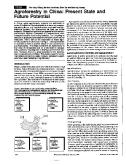| dc.description.abstract | In China, major agroforestry systems are estimated to cover 45 million ha. Agrosilviculture is a dominant practice. Aquasilvicultures, e.g. tree-fish-arable crop and tree-fish-livestock systems, are alternatives for land use in the wetlands. Silvopastoral systems are popular in the northern and western regions. Compared to a monoculture, well-managed systems have many benefits. The recycling of residues is expected to increase the efficient use of natural resources. The C sink in the vegetation of major agroforestry systems in China was 179 Tg yr-1, and agroforestry is reported to have a positive effect on soil conservation and biodiversity. The major constraint on agroforestry is the most of the systems are on a low level of management, primarily resulting from a shortage of technical support. However, there is a great potential for the development of agroforestry in China. This paper presents recommendations concerning policy options, technical support, extension, and marketing in agroforestry. | es_ES |


